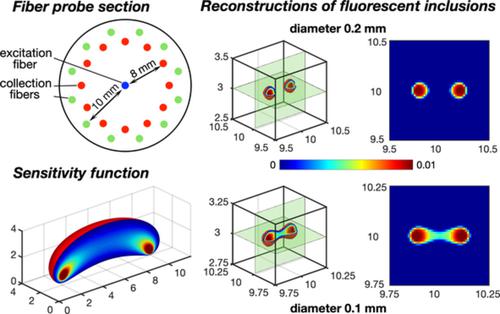当前位置:
X-MOL 学术
›
Int. J. Numer. Method. Biomed. Eng.
›
论文详情
Our official English website, www.x-mol.net, welcomes your feedback! (Note: you will need to create a separate account there.)
Early‐photon reflectance fluorescence molecular tomography for small animal imaging: Mathematical model and numerical experiment
International Journal for Numerical Methods in Biomedical Engineering ( IF 2.1 ) Pub Date : 2020-10-23 , DOI: 10.1002/cnm.3408 Alexander B Konovalov 1, 2 , Vitaly V Vlasov 1, 2 , Alexander S Uglov 1
International Journal for Numerical Methods in Biomedical Engineering ( IF 2.1 ) Pub Date : 2020-10-23 , DOI: 10.1002/cnm.3408 Alexander B Konovalov 1, 2 , Vitaly V Vlasov 1, 2 , Alexander S Uglov 1
Affiliation

|
The paper presents an original approach to time‐domain reflectance fluorescence molecular tomography (FMT) of small animals. It is based on the use of early arriving photons and state‐of‐the‐art compressed‐sensing‐like reconstruction algorithms and aims to improve the spatial resolution of fluorescent images. We deduce the fundamental equation that models the imaging operator and derive analytical representations for the sensitivity functions which are responsible for the reconstruction of the fluorophore absorption coefficient. The idea of fluorescence lifetime tomography with our approach is also discussed. We conduct a numerical experiment on 3D reconstruction of box phantoms with spherical fluorescent inclusions of small diameters. For modeling measurement data and constructing the sensitivity matrix we assume a virtual fluorescence tomograph with a scanning fiber probe that illuminates and collects light in reflectance geometry. It provides for large source‐receiver separations which correspond to the macroscopic regime. Two compressed‐sensing‐like reconstruction algorithms are used to solve the inverse problem. These are the algebraic reconstruction technique with total variation regularization and our modification of the fast iterative shrinkage‐thresholding algorithm. Results of our numerical experiment show that our approach is capable of achieving as good spatial resolution as 0.2 mm and even better at depths to 9 mm inclusive.
中文翻译:

用于小动物成像的早期光子反射荧光分子断层扫描:数学模型和数值实验
该论文提出了一种对小动物进行时域反射荧光分子断层扫描 (FMT) 的原创方法。它基于使用早期到达光子和最先进的类似压缩传感的重建算法,旨在提高荧光图像的空间分辨率。我们推导出对成像算子建模的基本方程,并推导出负责重建荧光团吸收系数的灵敏度函数的解析表示。还讨论了使用我们的方法进行荧光寿命断层扫描的想法。我们对具有小直径球形荧光夹杂物的箱形体模进行 3D 重建的数值实验。为了模拟测量数据和构建灵敏度矩阵,我们假设虚拟荧光断层扫描仪带有扫描光纤探头,该探头在反射几何中照射和收集光。它提供了对应于宏观区域的大源-接收器分离。两种类似压缩感知的重建算法用于解决逆问题。这些是具有全变分正则化的代数重建技术和我们对快速迭代收缩阈值算法的修改。我们的数值实验结果表明,我们的方法能够实现 0.2 毫米的良好空间分辨率,甚至在深度达到 9 毫米时甚至更好。它提供了对应于宏观区域的大源-接收器分离。两种类似压缩感知的重建算法用于解决逆问题。这些是具有全变分正则化的代数重建技术和我们对快速迭代收缩阈值算法的修改。我们的数值实验结果表明,我们的方法能够实现 0.2 毫米的良好空间分辨率,甚至在深度达到 9 毫米时甚至更好。它提供了对应于宏观区域的大源-接收器分离。两种类似压缩感知的重建算法用于解决逆问题。这些是具有全变分正则化的代数重建技术和我们对快速迭代收缩阈值算法的修改。我们的数值实验结果表明,我们的方法能够实现 0.2 毫米的良好空间分辨率,甚至在深度达到 9 毫米时甚至更好。
更新日期:2020-10-23
中文翻译:

用于小动物成像的早期光子反射荧光分子断层扫描:数学模型和数值实验
该论文提出了一种对小动物进行时域反射荧光分子断层扫描 (FMT) 的原创方法。它基于使用早期到达光子和最先进的类似压缩传感的重建算法,旨在提高荧光图像的空间分辨率。我们推导出对成像算子建模的基本方程,并推导出负责重建荧光团吸收系数的灵敏度函数的解析表示。还讨论了使用我们的方法进行荧光寿命断层扫描的想法。我们对具有小直径球形荧光夹杂物的箱形体模进行 3D 重建的数值实验。为了模拟测量数据和构建灵敏度矩阵,我们假设虚拟荧光断层扫描仪带有扫描光纤探头,该探头在反射几何中照射和收集光。它提供了对应于宏观区域的大源-接收器分离。两种类似压缩感知的重建算法用于解决逆问题。这些是具有全变分正则化的代数重建技术和我们对快速迭代收缩阈值算法的修改。我们的数值实验结果表明,我们的方法能够实现 0.2 毫米的良好空间分辨率,甚至在深度达到 9 毫米时甚至更好。它提供了对应于宏观区域的大源-接收器分离。两种类似压缩感知的重建算法用于解决逆问题。这些是具有全变分正则化的代数重建技术和我们对快速迭代收缩阈值算法的修改。我们的数值实验结果表明,我们的方法能够实现 0.2 毫米的良好空间分辨率,甚至在深度达到 9 毫米时甚至更好。它提供了对应于宏观区域的大源-接收器分离。两种类似压缩感知的重建算法用于解决逆问题。这些是具有全变分正则化的代数重建技术和我们对快速迭代收缩阈值算法的修改。我们的数值实验结果表明,我们的方法能够实现 0.2 毫米的良好空间分辨率,甚至在深度达到 9 毫米时甚至更好。


























 京公网安备 11010802027423号
京公网安备 11010802027423号